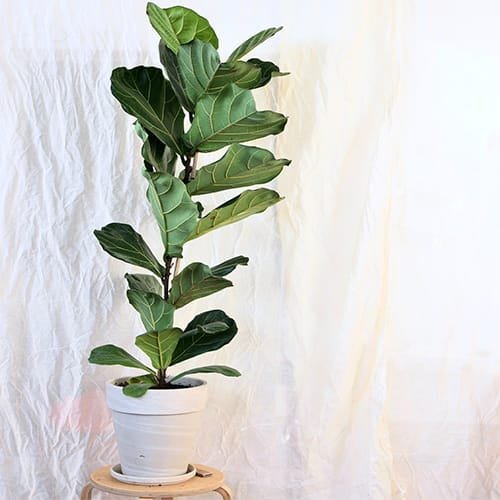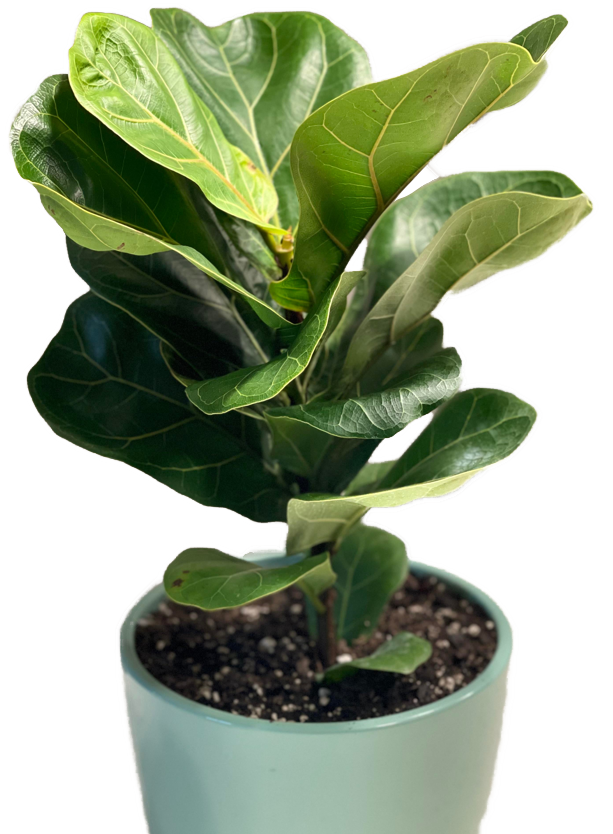Difference between Fiddle Leaf Fig and Fiddle Leaf Fig “Bambino”
There exist two varieties of FLF, the normal variety that is fast in growth and irregular in shape, and the smaller brother which is known as FLF “bambino” which is slower in growth and comes out in compact form generally in a straight manner.
the maximum height that FLF can reach is up to 5-10 feet unlike its smaller brother ( the bambino variety) which can grow till 2-5 feet.
If you are a passionate Plant Parent then don’t miss the chance of adding any one of the cool variety of FLF’s.
FIDDLE LEAF FIG
Ficus Lyrata is a wonderful and incredibly rewarding plant to grow indoors.  They make beautiful corner plants and large indoor “trees” for entryways and foyers.
They make beautiful corner plants and large indoor “trees” for entryways and foyers.
with large glossy leaf span, this variety is highly popular among the plant parent community.
FIDDLE LEAF FIG BAMBINO
Fiddle Leaf Fig Bambino is an exotic compact variety of the most famous Fiddle Leaf Fig (FLF), this particular variety is widely popular in modern home decor purposes,
making it the first choice in the plant parents community.
How to differentiate?
It’s fairly easy to point out Fiddle leaf fig’s from other indoor plants varieties. FLF’s have characteristic wide, rough-textured, glossy thick leaves with the unique thin trunky stem.
when it comes to differentiating between “bambino” and “non-bambino” variety the main differentiating factor is the compactness of the leaves and the size and shape of leaf, the bambino variety has compact leaf growth closer to the main trunk, and the leaf size of the bambino variety is fairly smaller in dwarf as compared to the “non bambino ” variety.
Care Guide📚:
Sunlight: Generally grows best in bright indirect sunlight, this plant will love to receive morning sunlight. your North-facing window will work absolutely great for this lovely plant.
Water: Keep steadily moist, but don’t allow it to sit in water or it will drop leaves and suffer from root rot.
Soil: Any good, fast-draining potting soil will likely do.
Fertilizer: These are heavy feeders and need plenty of fertilizer throughout the growing season, start fertilizing once a month and in small quantities, and gradually increase the quantity in subsequent months, observe the change in plant health if it gets better. (secret:?(•_•) over-fertilizing might kill your plant so start fertilizing in small quantity)
Propagation
Ficus Lyrata can be relatively easily rooted from cuttings, even without rooting hormone. It’s best to take a cutting in the spring when you can more easily supply warmth and moisture. Ficus is rarely grown from seed and most indoor plants will never fruit or yield seed.
Repotting
Don’t miss the chance of having your hands dirty with this one, FLF doesn’t like to be root bound, repot the plant as soon as you feel that the plant growth is slowing down or if the roots become visible outside the pot. and use good quality soil mix while repotting.
Grower’s Tips
Ficus Lyrata is a wonderful and incredibly rewarding plant to grow indoors. They make beautiful corner plants and large indoor “trees” for entryways and foyers.
Ficus is one of the most popular houseplants in the world. Known as the weeping fig, the F. Benjamina is native to India and Southeast Asia, where its an important fruit and landscape plant. One of the common complaints about F. Benjamina is its tendency to shed leaves easily: you move it, it drops leaves; the watering schedule changes, it drops leaves. It might help to know that part of this is because of the way these plants have evolved. F. Benjamina are native to the subtropics and tropics where there is a distinct wet and dry season. In their native environment, plants typically drop leaves at the beginning of the dry season, making them exquisitely sensitive to changes in moisture. In terms of indoor culture, they are not especially demanding, but dislike being moved and, as mentioned before, they are highly sensitive to changes in watering.
Plant Care
Light
Thrives in bright medium to high indirect sunlight. A few hours of morning full sun is preferred.
Water
Water every 1-2 weeks, allowing soil to dry out between waterings. Increase frequency with increased light.
Plant Tip
shake the stem of this plant gently and it will strengthen the roots and promote new growth.

